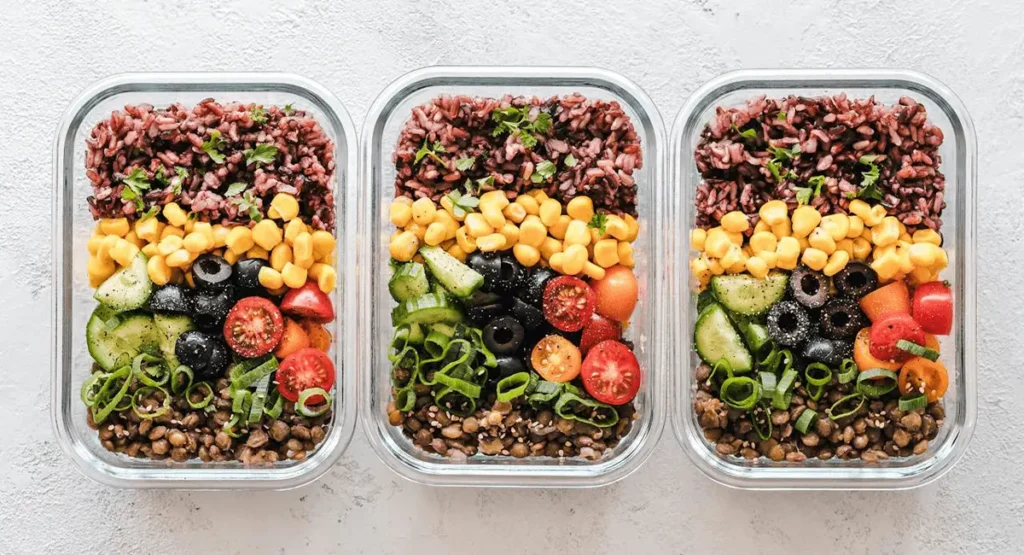
Did you know that 95% of people who attempt dramatic diet changes return to their old eating patterns within a year? The problem isn’t willpower or motivation. It’s the approach. While crash diets and extreme nutrition overhauls promise quick results, they fail to create lasting eating behavior change. The secret to sustainable eating habits lies in small, consistent actions that become automatic over time.
Research from Stanford University shows that successful healthy lifestyle transformations happen through habit formation, not willpower alone. When you build nutrition habits gradually, your brain rewires itself to make healthy choices feel natural and effortless.
This article reveals 10 simple healthy eating habits that actually stick, backed by science and designed to work for people worldwide, regardless of their cultural background or lifestyle.
Why Most Healthy Eating Plans Fail
The diet industry generates billions of dollars annually by selling the same flawed premise: dramatic changes lead to dramatic results. Unfortunately, this all-or-nothing mentality sets people up for failure. When you drastically restrict calories or eliminate entire food groups, your body and mind rebel against the sudden change.
Complex nutrition rules create decision fatigue. Having to calculate macros, weigh portions, and follow rigid meal schedules exhausts your mental resources. According to research published in the Journal of Consumer Psychology, people make over 200 food-related decisions daily. Adding complicated diet rules to this already overwhelming process makes failure almost inevitable.
Willpower operates like a muscle that gets tired with overuse. Relying solely on self-control to maintain healthy eating habits is unsustainable. Studies from the University of Minnesota demonstrate that people who depend on willpower alone for eating behavior change experience higher stress levels and lower success rates compared to those who focus on building automatic habits.
Cultural and lifestyle barriers also contribute to plan failure. Generic diets often ignore individual food preferences, work schedules, family dynamics, and budget constraints. A meal plan that works for a single professional in New York may be completely impractical for a parent of three in Mumbai or a shift worker in São Paulo.
The solution isn’t more restriction or stronger willpower. It’s creating sustainable eating habits that align with your natural behavior patterns and lifestyle demands.
The Science Behind Habit Formation and Nutrition
Understanding how habits form is crucial for developing lasting nutrition habits. MIT researchers have identified the neurological habit loop: cue, routine, and reward. Your brain recognizes a trigger (cue), performs an action (routine), and experiences a benefit (reward). Over time, this loop becomes automatic, requiring minimal conscious effort.
The 21-day myth has been thoroughly debunked. According to Dr. Phillippa Lally’s research at University College London, it takes an average of 66 days to form a new habit, with a range of 18 to 254 days depending on the complexity and individual differences. Simple nutrition habits like drinking water upon waking form faster than complex behaviors like preparing elaborate healthy meals.
Neuroplasticity research reveals that your brain can rewire food preferences throughout your lifetime. The more you repeat healthy eating patterns, the stronger those neural pathways become. Eventually, choosing nutritious foods feels as natural as your current automatic behaviors.
The principle of marginal gains, popularized by British Cycling, applies perfectly to nutrition habits. Small improvements, consistently applied, compound into significant results. A 1% daily improvement in your eating habits leads to 37 times better results over a year through the power of compound growth.
This scientific foundation explains why the 10 healthy eating habits outlined below work so effectively. They’re designed to work with your brain’s natural learning patterns, not against them.
Also read: The Ultimate Guide to Eating Healthy: What to Eat, What to Avoid, and How to Build Better Habits
10 Simple Healthy Eating Habits That Actually Stick
1. Start Your Day with Water
Morning hydration jumpstarts your metabolism and sets a positive tone for healthy choices throughout the day. After 6-8 hours without fluid intake, your body is naturally dehydrated. Drinking water immediately upon waking helps restore optimal hydration levels and can increase metabolic rate by up to 30% according to research from the Journal of Clinical Endocrinology and Metabolism.
To make this habit automatic, place a glass of water on your bedside table each night. This visual cue eliminates decision-making and friction from the morning routine. Some people prefer room temperature water, while others enjoy it cold or with a slice of lemon for added flavor and vitamin C.
Track this habit for the first two weeks by placing a checkmark on your calendar or using a simple habit-tracking app. The immediate reward of feeling more alert and energized will help reinforce this healthy lifestyle change.
2. Fill Half Your Plate with Vegetables
Visual portion control simplifies healthy eating without requiring scales, measuring cups, or calorie counting. The Harvard School of Public Health’s Healthy Eating Plate recommends filling half your plate with vegetables and fruits, making this one of the most effective healthy diet tips for automatic portion management.
Preparation is key to making vegetables convenient. Spend 20 minutes on Sunday washing, chopping, and storing vegetables in clear containers at eye level in your refrigerator. This meal planning strategy removes barriers and makes healthy choices the easy choice during busy weekdays.
Budget-conscious options include seasonal vegetables, frozen varieties (which retain most nutrients), and buying in bulk. Cabbage, carrots, onions, and seasonal produce offer excellent nutrition value globally. Frozen mixed vegetables provide convenience without sacrificing nutritional quality and often cost less than fresh options.
3. Practice Mindful Eating
Mindful eating transforms your relationship with food by engaging your senses and awareness during meals. This practice helps you recognize hunger and fullness cues, leading to natural portion control and greater meal satisfaction. Research from Harvard Medical School shows that mindful eating can reduce overeating by up to 40%.
Start by eating without distractions. Turn off television, put away phones, and focus solely on your meal. Chew each bite slowly, noticing flavors, textures, and aromas. This simple change activates your parasympathetic nervous system, improving digestion and nutrient absorption.
Practice the 20-minute rule. It takes approximately 20 minutes for your brain to register fullness signals from your stomach. Eating slowly allows these signals to prevent overconsumption naturally. Set your fork down between bites or engage in conversation to naturally pace your eating.
4. Plan Your Meals in Advance
Meal planning is one of the most powerful sustainable eating habits for busy lifestyles. When you plan meals in advance, you eliminate decision fatigue and reduce the likelihood of choosing convenience foods that may not align with your health goals.
Start simple with a weekly planning session. Choose one day to plan the upcoming week’s meals, considering your schedule, available ingredients, and family preferences. Write down three breakfast options, four lunch ideas, and five dinner possibilities. This flexibility prevents boredom while maintaining structure.
Batch cooking maximizes efficiency. Prepare grains, proteins, and roasted vegetables in larger quantities during less busy times. Store these components separately so you can mix and match throughout the week. This approach works well for various cultural cuisines and dietary preferences.
5. Keep Healthy Snacks Visible
Environmental design psychology shows that food placement significantly influences consumption patterns. Items at eye level get chosen 5 times more often than those stored in less visible locations. Apply this principle by keeping nutritious snacks in prominent, accessible places.
Stock your workspace, car, and home with portable healthy options. Nuts, seeds, fresh fruit, and vegetable sticks travel well and provide sustained energy. Prepare weekly snack portions in clear containers to grab quickly when hunger strikes.
Replace less nutritious options gradually rather than eliminating everything at once. This sustainable approach prevents feelings of deprivation that often lead to rebound overeating. Focus on addition before subtraction in your eating behavior change journey.
6. Cook More Meals at Home
Home cooking gives you complete control over ingredients, portion sizes, and cooking methods. People who cook at home regularly consume fewer calories, less sugar, and more nutrients compared to those who rely heavily on restaurant meals or processed foods, according to Johns Hopkins School of Public Health research.
Start with simple techniques that work across cultures. Basic methods like steaming, roasting, and sautéing require minimal equipment and work with virtually any ingredients. A sharp knife, cutting board, and one good pan can prepare thousands of healthy meals.
Time-saving tools make home cooking more convenient. A slow cooker, pressure cooker, or rice cooker can prepare complete meals with minimal active cooking time. These appliances work well for busy schedules and help develop consistent nutrition habits.
7. Read Food Labels Mindfully
Understanding food labels empowers you to make informed choices about packaged foods. Focus on the ingredient list rather than marketing claims on the front of packages. Ingredients are listed by weight, so items appearing first make up the largest portion of the product.
Watch for hidden sugars, which appear under dozens of different names including high fructose corn syrup, agave nectar, brown rice syrup, and cane juice. The American Heart Association recommends limiting added sugars to 25 grams daily for women and 36 grams for men.
Pay attention to serving sizes, which are often smaller than what people typically consume. A package that appears to contain 2 servings might realistically be consumed as 1 serving, doubling the calories, sodium, and sugar intake listed on the label.
Also read: How to Read Nutrition Labels Like a Pro: Complete Guide 2025
8. Stay Consistent with Meal Timing
Regular meal timing helps regulate your circadian rhythms, improves metabolism, and stabilizes blood sugar levels throughout the day. Research from the Salk Institute shows that eating within a consistent 10-12 hour window can improve metabolic health even without changing food choices.
Establish realistic meal windows that work with your schedule. If you wake at 6 AM, consider eating your first meal around 7 AM and your last meal by 7 PM. This approach allows flexibility for social events while maintaining overall consistency.
Balance structure with flexibility to maintain sustainable eating habits. If your schedule varies due to shift work or travel, focus on maintaining consistent intervals between meals rather than strict clock times. The goal is supporting your body’s natural rhythms, not creating additional stress.
9. Choose Whole Foods Over Processed
Whole foods provide more nutrients, fiber, and satiety compared to their processed counterparts. They also contain fewer additives, preservatives, and hidden sugars that can interfere with natural hunger cues and energy levels.
Make simple swaps gradually. Replace white rice with brown rice, refined pasta with whole grain varieties, and sugary cereals with oats or eggs. These substitutions maintain familiar flavors while improving nutritional quality.
Shop the perimeter of the grocery store first, where fresh produce, dairy, and proteins are typically located. Fill most of your cart with these items before venturing into center aisles where processed foods dominate. This strategy naturally guides you toward whole food choices.
10. Allow Yourself Flexibility
The 80/20 approach to nutrition habits prevents the perfectionism that often derails healthy eating efforts. Aim to make nutritious choices 80% of the time while allowing 20% flexibility for social events, treats, and spontaneous food experiences.
Plan for indulgences rather than feeling guilty about them. If you know you have a dinner party on Saturday, eat particularly well during the week and enjoy the celebration without self-judgment. This balanced approach maintains sustainable eating habits long-term.
Develop a growth mindset around eating behavior change. View occasional less-than-optimal choices as learning opportunities rather than failures. Each meal is a new chance to nourish your body, regardless of previous choices.
How to Implement These Habits Successfully
Start with one habit at a time to avoid overwhelming your brain’s capacity for change. Choose the habit that feels most achievable and interesting to you personally. Master one habit for 2-3 weeks before adding another. This approach ensures long-term success rather than short-term enthusiasm followed by burnout.
Track your progress using simple methods that don’t create additional stress. A basic calendar with checkmarks, a notes app on your phone, or a dedicated habit-tracking application can help you stay aware without becoming obsessive. Focus on consistency over perfection.
Build your support system by sharing your goals with family and friends. Having social support increases your likelihood of success by up to 95% according to research from the American Society of Training and Development. Consider joining online communities focused on healthy lifestyle changes or finding an accountability partner.
When setbacks occur, and they will, practice self-compassion. Research from Kristin Neff at the University of Texas shows that self-compassion improves motivation and reduces the likelihood of giving up entirely. Treat yourself with the same kindness you would offer a good friend facing similar challenges.
Common Obstacles and How to Overcome Them
Time constraints represent the most common barrier to developing nutrition habits. Combat this by focusing on preparation during less busy periods. Spend 30 minutes on Sunday preparing vegetables, cooking grains, or planning the week’s meals. This small investment saves hours of decision-making during hectic weekdays.
Budget limitations don’t have to prevent healthy eating. Focus on affordable staples like beans, lentils, eggs, seasonal vegetables, and whole grains. Frozen vegetables and fruits often cost less than fresh options while retaining similar nutritional value. Buy generic brands and shop sales to stretch your food budget further.
Family and social pressures can derail individual healthy eating efforts. Communicate your goals clearly and suggest compromises that work for everyone. Offer to bring healthy dishes to gatherings or suggest restaurants with nutritious options. Remember that you can only control your own choices, not others’ reactions.
Cultural food preferences and dietary restrictions require creative adaptation rather than abandonment of nutrition goals. Every cuisine contains healthy traditional foods that can form the foundation of sustainable eating habits. Research traditional preparation methods and emphasize vegetables, whole grains, and lean proteins within your cultural context.
Measuring Success Beyond the Scale
Energy levels provide one of the earliest indicators of improved nutrition habits. Many people notice increased afternoon energy and reduced post-meal fatigue within days of implementing these changes. Pay attention to your energy patterns throughout the day as a measure of progress.
Sleep quality often improves with better nutrition habits. Stable blood sugar levels from regular, balanced meals can reduce nighttime sleep disruptions. Track your sleep quality and duration as another metric of successful healthy lifestyle changes.
Digestive health improvements may include reduced bloating, more regular bowel movements, and decreased acid reflux. These changes often occur within the first few weeks of implementing mindful eating and increasing vegetable intake.
Long-term health markers like blood pressure, cholesterol levels, and blood sugar can be measured through regular healthcare checkups. These objective measures provide concrete evidence of your sustainable eating habits’ impact on overall health.
Also read: Top 10 Drinks To Lose Belly Fat
FAQ
How long does it take to form healthy eating habits?
Research shows it takes an average of 66 days to form new habits, but this varies widely from 18 to 254 days depending on the complexity of the habit and individual factors. Simple habits like drinking water upon waking form faster than complex behaviors like meal planning.
Can I implement all 10 habits at once?
No, attempting to change too many behaviors simultaneously often leads to failure. Start with one habit that feels most achievable and practice it for 2-3 weeks before adding another. This approach ensures sustainable eating behavior change.
What if I have dietary restrictions or food allergies?
These healthy eating habits can be adapted to any dietary requirements. Focus on the underlying principles (hydration, vegetables, whole foods, mindful eating) and apply them within your dietary constraints. The habits are flexible frameworks, not rigid rules.
How do I handle social situations that don’t align with my healthy eating goals?
Use the 80/20 approach. Make nutritious choices most of the time while allowing flexibility for social events. You can also eat a small healthy snack before events, focus on socializing rather than eating, or offer to bring a nutritious dish to share.
What should I do if I slip up and abandon my healthy eating habits?
Practice self-compassion and return to your habits at the next meal. One less-than-optimal choice doesn’t erase previous progress. View setbacks as learning opportunities and focus on getting back on track rather than dwelling on mistakes.
Are these habits suitable for weight loss?
While these habits aren’t specifically designed for weight loss, many people experience natural weight management as a side effect of improved nutrition habits. Focus on building sustainable behaviors rather than pursuing weight loss as the primary goal for better long-term results.
How can I make healthy eating affordable on a tight budget?
Focus on affordable staples like beans, lentils, eggs, seasonal vegetables, frozen produce, and whole grains. Buy generic brands, shop sales, and prepare meals at home. These strategies make nutritious eating accessible regardless of budget constraints.
Can children and teenagers follow these healthy eating habits?
Yes, these habits are appropriate for all ages with minor modifications. Children may need smaller portions and more frequent meals. Involve kids in meal planning and preparation to build positive relationships with food from an early age.
Creating lasting healthy eating habits requires patience, consistency, and self-compassion. These 10 proven strategies work because they align with how your brain naturally forms habits while addressing real-world challenges like time constraints, budget limitations, and social pressures.
Remember that sustainable eating habits develop gradually through small, consistent actions. Choose one habit that resonates with you and commit to practicing it for the next two weeks. As it becomes automatic, add another habit to your routine.
Your relationship with food can transform from a source of stress into a foundation for energy, health, and enjoyment. Start today with one small change, and trust the process of gradual improvement. Your future self will thank you for taking this important step toward lifelong wellness.
The journey to better health begins with a single choice. Which habit will you start with today?





